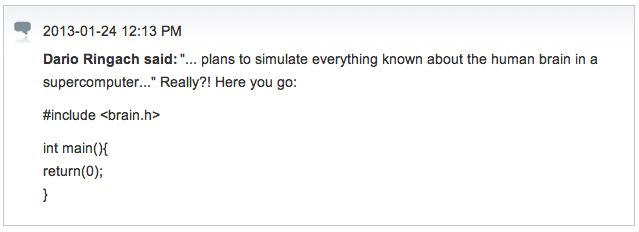Markram’s Millions
Henry Markram got his wish. He was just awarded 500,000,000 Euros to build a computer model of the brain. In NIH terms, that’s over 100 R01s for 10 years (including indirects). Will Markram’s program generate as much scientific insight as 10 years worth of 100 R01s would?
Spoiler alert:
No.
To paraphrase Movshon, I’m not going to argue against getting more data. However, one real concern is: what projects are going to go unfunded in order to provide unprecedented funding to this particular project?
Leaders in computational neuroscience, including Larry Abbott and Alex Pouget, have given their input, and it’s far from universal support (pdf link).
If you’re not a fan of the R01 unit of measure, I can put this in other terms for you:
500,000,000 Euros is about 670 million US dollars.
That’s about a third of Caltech’s entire endowment. It’s almost as much as HHMI spends on all their biomedical research per year. It dwarfs the MRC’s entire annual budget. Celera sequenced the human genome for less than half that amount.
Here’s a pile of over 200 million US dollars. This funding is 3x that amount.
On the up side, Dario Ringach has helpfully given Markram a great starting point.



It’s sure the overhyped claims that sold the project to the EU and to the media do not help. However, one must keep in mind that it is a consortium of over 100 labs that will get this money. For exemple people in Paris will set up an institute devoted to modeling in neuroscience. I’d say it’s unfortunate that the high-profile personality of Markram makes the whole thing look like it will be “Markram’s money”.
Rather than “€500M for Markram to model the whole human brain”, it should be more like “€500M to push computational neuroscience to the next level, in order to foster advances for all neurosciences”.
dario ringach summarizes the main issue with this project.
does anyone know how the funding will be distributed or spent?
and the project must have _some_ experimental components???
It’s just hard for me to imagine what 50,000,000 Euro every year can possibly buy… I guess I just can’t think big enough.
can he start by simulating the part of the brain that sweet talks donors into giving out $500,000,000? that would be a useful thing to have.
This could hurt us very badly. When I discussed the (stunning) news with Kati yesterday, she brought up Hans Christian Andersen’ s “The Emperor’s New Clothes” ( http://www.ddr-hoerspiele.net/bilder/cover/lp/Des-Kaisers-neue-Kleider.jpg ). The analogy is right on and even suggests a potential way out. Only at the end does the Emperor actually loose his clothes, and that only because no one dared to speak out. With community mobilisation we might be able influence regulators and project leads in a way that might prevent too much damage. But that will require a lot more mobilisation than we have seen thus far.
From the HBP FAQ:
http://www.humanbrainproject.eu/neuroscience.html
” Why not begin with simple organisms like C.elegans?
There are two problems here. The first is feasibility; the second is the relevance of our results.
Feasibility. Neuroscientists have mapped all of C.elegans’ 300 or so neurons. However, enormous amounts of key data needed are still missing. For instance we do not have enough data on the physiology and pharmacology of C. Elegans neurons and synapses. And we still have limited data on the distribution of ion channels, receptors and other proteins on neurons, synapses and glia. Without this data we cannot build unifying models. A second problem is how easy it is to obtain the data. The crucial requirement for unifying models is the ability to access the data needed. Obtaining a deep understanding of the molecular machinery of a single neuron or a single synapse is just as difficult in C. Elegans as in human beings. And many datasets – particularly data on cognition – are actually easier to acquire in rodents, or even in humans. So we can’t just say: “let’s do this quickly in worms and do complex brains later”: we have to solve the same basic challenges, whatever brain we model. What we are actually doing is building a generic strategy we can use to reconstruct any brain. “
@Dario’s comment: so much win here.
probably easier to model the brain of all those commenting on article….
[…] More info […]